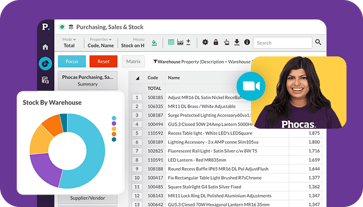Make day-to-day financial tasks a treat, not a trick
Around this time of year, we embrace the spooky, creepy, and downright terrifying.
Witches, ghosts, and ghouls are a common sight. Some of us even actively seek out thrills by visiting haunted houses.
But even for the thrill-seekers among us, there’s nothing quite as scary as a finance department facing work backlogs due to reliance on manual processes. Even though spreadsheets may be the go-to tool for these departments, we can all agree they come with a dark side.
For instance: It’s easy to get spooked by a lot of data when working with spreadsheets. It can be challenging to create reports and budgets with all that data. You’re also dealing with multiple versions haunting your company. This slows work down and creates issues of accuracy. The departments outside of finance also tend to get frightened by the data in the reports you generate with information and numbers they don’t really understand.
But you don’t have to deal with these year-round frights. Purpose-built financial software automates the more cumbersome tasks like creating reports and budgets, so you can focus on the more meaningful—and fun!—elements of your job, like analysis and providing strategic counsel.
Here are some ways financial software can remove the fear from your finance department:
1. Improves productivity
Moving your financial manual tasks from spreadsheets to a focused financial solution can immediately result in productivity gains. Even with an experienced finance staff, you’re likely to spend hours searching for specific figures hidden within spreadsheets, or creating analytical reports for relevant stakeholders. Up to 50% of organizations take more than three months to finalize budgets in a manual process, according to research conducted by PwC.
When you use an intuitive finance software platform, the data pulls automatically from your existing ERP and other sources. People can create budgeting and forecasting reports with the click of a button. They no longer have to collect data and input it by hand. That frees them up for more valuable tasks, like performing analysis and diagnosing issues.
2. Enables analysis of comprehensive data (from many different sources)
In these challenging times, businesses need to be able to access data from different sources to make critical decisions. Unfortunately, some finance managers have the terrifying task of downloading multiple data sets in different formats and consolidating them into one spreadsheet. This both wastes time and can lead to errors if there’s an error in one of the files.
A solution like Phocas automatically consolidates data from your ERP and other business systems, creating one source of truth. Once the data’s in that single system, you can access it on a dashboard in real-time, so you’re not shaking in your shoes about multiple or incorrect versions of the data floating around.
3. Helps visualize performance and find trends
Traditional, static spreadsheets may provide the basic information you need. However, you may be missing out on the next level of detail. Spreadsheets don’t provide a visualization of your company’s financial data, nor do they excel at capturing trends or showing missed opportunities.
With an interactive dashboard tool, you can better visualize financial performance and determine whether there are issues that need exploring. You can choose to customize financial statements to better understand your results and analysis with diagrams, tables, and graphics. For instance, if you can add profitability ratios so you compare how the company is performing this year to past periods. or between departments. Often cross departmental trends can provide great insight into how different areas are managed within your own business.
4. Enhances security
Financial data in spreadsheets tends to be highly protected and confidential. That’s why most finance departments that rely on spreadsheets restrict their access from the rest of the company.
With the help of purpose-built financial software, your team can share the numbers and reports with other team members—with no risk of accessing information that isn’t directly relevant to their roles. Your team chooses what to disclose, with built-in data security and permissions.
To find out more about how you can upgrade your financial spreadsheets, download our ebook, Spreadsheets work, but not for FP&A


Katrina is a professional writer with a decade of experience in business and tech. She explains how data can work for business people and finance teams without all the tech jargon.
Related blog posts

Asahi Group (a large beverage manufacturer and distributor) recently experienced a cyberattack that didn’t destroy the business, but did create the kind of operational and financial mess most mid-market companies recognize. Orders couldn’t be processed normally, shipments were delayed, call centres were disrupted and some products became temporarily hard to get in retail and hospitality channels. The impact showed up quickly in results. Domestic sales dropped materially for a period while systems were restored and workarounds were put in place.
Read more
Intercompany journals are like transferring stock between two warehouses in the same distribution group. One warehouse records inventory going out at as an internal transfer price, and the other records it coming in. The group hasn’t gained or lost anything — it’s just tracking the internal movement.
Read more
Finance departments in mid-market companies are planning more. Why? Because the market is volatile and competitive, and to stay profitable and keep customers coming back, business planning has become mandatory.
Read more
Communicating financial statements effectively is one of the most important responsibilities for finance professionals. Whether you're advising the sales team or preparing updates for board members, you need to meet them where they are. Financial reporting is about ensuring your stakeholders can understand the company’s financial position, profitability and overall financial performance.
Read moreBrowse by category

Find out how our platform gives you the visibility you need to get more done.
Get your demo today